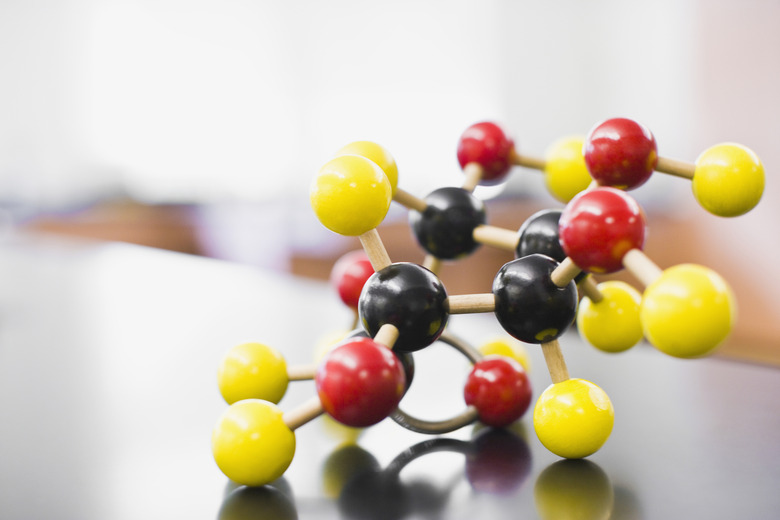Why Do Most Atoms Form Chemical Bonds?
If you have come along in your chemistry instruction, you've encountered the topic of chemical bonds between atoms and molecules, and maybe you even learned the names of a few (which are quite cool, in fact). But if someone asked you to give three reasons for chemical bond formation, would you be able to help your curious friend?
There are a number of types of chemical bonds, as you'll learn, but all bonds between atoms form for the same essential reason: the opportunity for the atoms involved to complete their outermost electron shells, or valence shells. Like a lot of the living beings atoms make up, no type of atom (and there are 118 individual kinds, called elements) is in its most comfortable state while existing alone.
Basics of the Atom
Basics of the Atom
All atoms have one or more **protons,** neutrons and electrons, except for hydrogen, which consists of one one proton and one electron. The number of protons and electrons is equal in neutral atoms and determines their individual identity, i.e., what element each of them is.
Because protons are positively charged while electrons carry a negative charge equal in magnitude to the proton's charge, the atom itself is neutral, as neutrons, befitting their name, have no charge. On the other hand, protons and neutrons are very similar in mass and occupy the center of the atom at the nucleus. The electrons are about 2,000 times less massive than the already tiny protons and neutrons.
Electrons are conceived of as flitting about some distance from the nucleus in quantized energy levels. Being on the ill-defined outer fringes of atoms, they are the subatomic particles that participate in chemical bonding.
The Classification of Chemical Bonds
The Classification of Chemical Bonds
There are three basic ways (or four, depending on your level of permissiveness) in which atoms can form a chemical bond; examples of each are given below.
The covalent bond: One reason atoms form bonds is that they are able to share electrons with other atoms to complete the valence shells of both. The valence shells of the lightest two elements, hydrogen and helium, can hold up to two electrons; the valence shells of most of the familiar elements can accommodate eight electrons. A water molecule, **H2O**, consists of three atoms and two identical covalent H–O bonds.
The ionic bond: A second reason atoms form bonds is that they are able to donate electrons to, or receive electrons from, other atoms to complete their respective valence shells. These bonds are usually stronger than covalent bonds because of the electronegativity difference between them (the physical impetus for a "donation" rather than a "sharing"). NaCl, or sodium chloride, is an ionic compound.
The metallic bond: A third reason atoms form bonds is that in some elements, called metals, the electrons in atoms in the same "neighborhood" wander far from their nuclei and become part of an "electron sea" in which the highest-energy electrons are not distinctly associated with any one parent nucleus. This occurs when metal is found in its monatomic form, that is, bonded only to itself; this is what is meant by "pure gold" or "pure platinum."
The hydrogen "bond": Hydrogen atoms, which in some molecules carry a slight positive charge, can form strong electrostatic attractions to negatively charged atoms on adjacent molecules. This occurs in liquids such as water, where these bonds account for water's unusually high boiling point among lightweight room-temperature liquids.
Why Do Atoms "Want" Full Valence Shells?
Why Do Atoms "Want" Full Valence Shells?
In brief, atoms are more "comfortable," or settled, from the standpoint of sheer energy when their valence shells are complete. While the analogy is imperfect, imagine a boulder being kept at the top of a mountain by unstable soil.
While the boulder can physically exist in this state while duly supported by dirt and rocks, if it had its "way," gravity would pull the rock toward the lowest available elevation to bring its potential energy to a minimal value.
Cite This Article
MLA
Beck, Kevin. "Why Do Most Atoms Form Chemical Bonds?" sciencing.com, https://www.sciencing.com/do-atoms-form-chemical-bonds-6331381/. 31 March 2020.
APA
Beck, Kevin. (2020, March 31). Why Do Most Atoms Form Chemical Bonds?. sciencing.com. Retrieved from https://www.sciencing.com/do-atoms-form-chemical-bonds-6331381/
Chicago
Beck, Kevin. Why Do Most Atoms Form Chemical Bonds? last modified August 30, 2022. https://www.sciencing.com/do-atoms-form-chemical-bonds-6331381/
